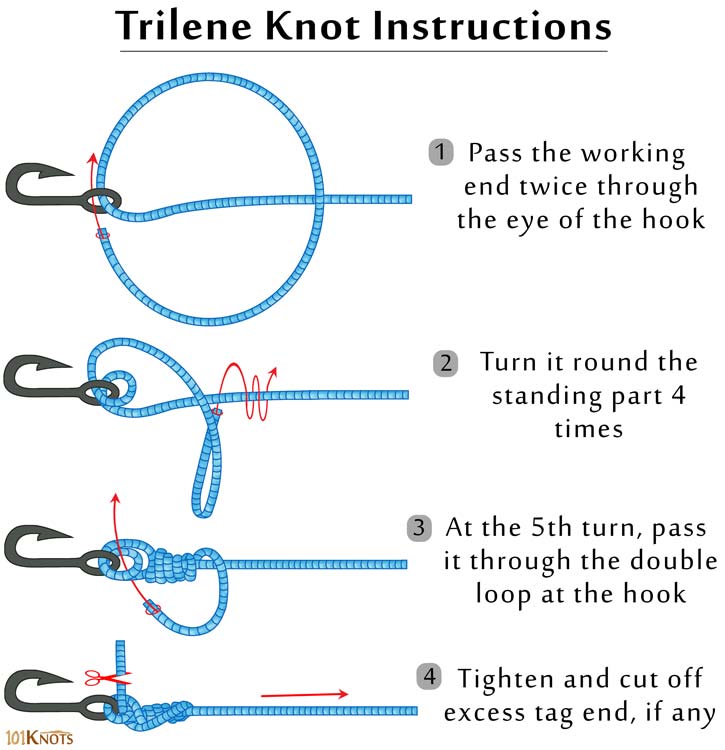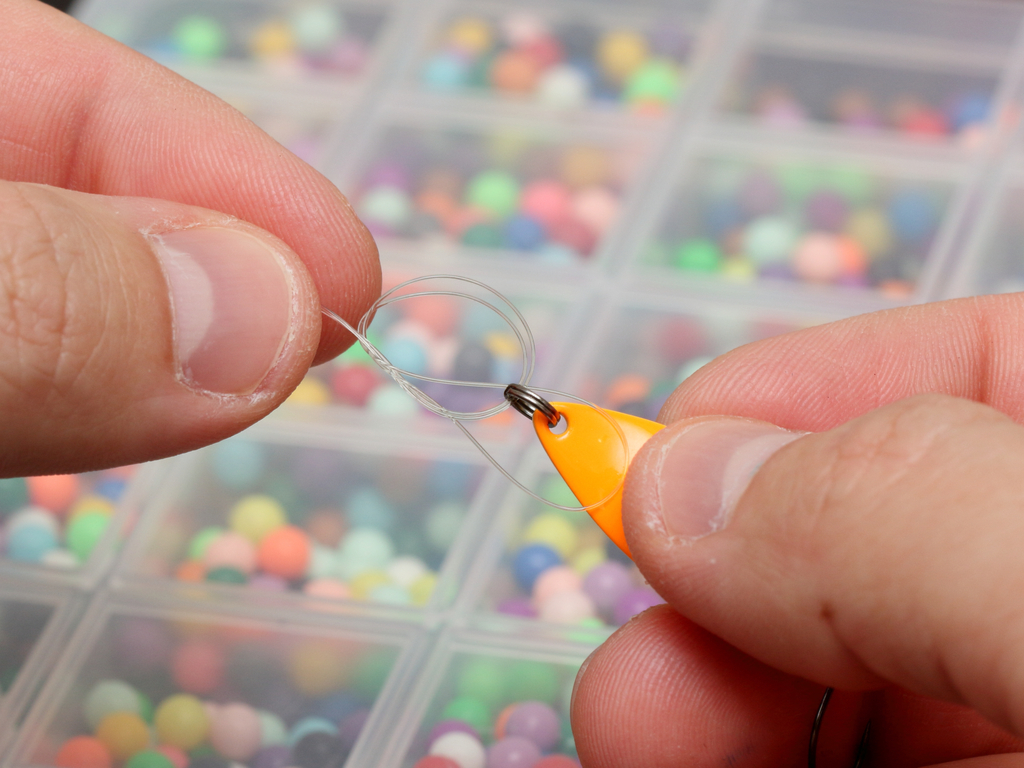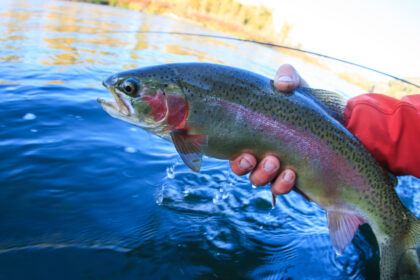They say that roughly ¾ of all fishing line failures can be attributed to poorly tied knots.
There’s probably a great degree of truth to that. While all of these knots have their own, unique names for them, most anglers probably couldn’t even tell you which one is which.
They all have their own knots and being able to set up their fishing rig is nearly a religious experience in terms of discipline, concentration, and precision. The reality is, you have probably asked yourself a time or two how in the world a 2lb fish just snapped your 15lb test.
It probably boils down to the type of knot you tied or rather, how well you tied the said knot. When you take a fishing line that is rated for 15lbs and wrap it around itself in whatever combination of loops and whorls suits your fishing routine, you may just be reducing that 15lb test to 8lbs, without even realizing it.
Below we’ll tackle how to tie some popular fishing knots.
Types of Fishing Line Knots
According to “pick your blog,” such and such is the greatest and most secure knot ever devised. Of course, that’s all a load of hogwash. The best knot is the one that’s tied for a particular task, including the knot being tied correctly.
Tying the perfect line on your hook isn’t the only knot for a fishing line. Many anglers prefer to purchase “leads”, made out of thicker material or made out of metal, that have various attachments along their length for adding weights, additional bait, or a bobber at the top.
If you really know your knots, however, you can essentially make your own leads without having to bother purchasing them ready-made. With that being said, there are a ton of different types of fishing knots and there are five that we will cover here:
- Double Surgeon’s Knot
- Dropper Loop Knot
- Trilene Knot
- Palomar Knot
- Rapala Knot
They all have their uses, including setting weights, hooks, fly fishing, and many others.
Double Surgeon’s Knot
The double surgeon’s knot gets its name from the surgeons who often use it to tie closed a suture. It’s also based on the square reef knot and it has a lot of uses in fishing, rather than just tying closed cuts and gashes.
The double surgeon’s knot is often used to tie on multiple flies when fly fishing and also for tying the leader to the tippet. It’s especially useful when tying two different lines of differing diameters.
If you are well acquainted with the double surgeon’s knot, you can purchase a much thicker line than the test that you are currently fishing with. Cut the thicker line down into smaller sections and manufacture your own leaders.
- Take the two lines that you are tying together and overlap them, situating them parallel to each other.
- With the two lines together, make a loop and run both lines through the loop you created.
- Pass both lines through the same loop again.
- Now pull the loop closed as tight as you can
There is also a triple version where you run the two lines through the loop a third time before tightening them together, instead of just the two. This knot creates a strong and tight lock between the two lines and retains almost 100% of the line’s original strength.
Dropper Loop Knot
The dropper loop is primarily designed for making several hook bait rings along the length of your line. In terms of complication, it’s definitely not the hardest knot to make, but it’s not one of the easiest to make either.
It’s a great line for deep-sea fishing where you’re dropping your bait vertically, along with adding multiple flies to your line when fly fishing. You can also use it to create different attachments but the much simpler double surgeon’s knot will make that a lot easier.
- Take a single line and form a loop with the loop above the crisscrossing lines.
- Grab the top of the loop and bring it down to wrap around the crisscrossed lines.
- Repeat that motion five more times.
- Now pass the top of your loop through the center of the hole.
- Use your teeth to pull the loop through the hole while using your left and right hands to pull each end of the line, tightening the knot.
It creates a nice loop that hangs off of your line at a 90° angle. You can make multiple versions of this along the line as well. Since they stick out at right angles, it’s difficult to tangle anything up.
While it’s a little more complicated than the double surgeon’s knot, it’s still an excellent knot and is pretty consistently labeled in the top ten fishing knots preferred by anglers.
Trilene Knot
The Berkley Tackle Company came up with this little knot and, according to them, it retains between 85% and 90% of the line strength once it’s secured.
This is primarily a knot for tying on your fish hook, although it can also be used for snaps, lures, and swivels. It’s an excellent knot and is a more complicated variation than the standard fish hook knot.
- Pass the line through the metal hoop at the end of the hook.
- Pass the line through the metal hoop a second time.
- Once you pass it through the second time wrap it around the standing line four to five times.
- On the last wrap-around, pass the line through the double loop just below the metal hook hoop.
- Once it’s through, tighten the line and cut off the excess line.

This knot is also known as the “two-turn clinch knot” and it’s a very powerful knot. It’s not on par with some of the other knots on this list, but if your line breaks, it will almost never be at the point of the knot, unless you fudged the knot somehow.
You can also use this knot to join monofilament and fluorocarbon lines together without sacrificing the strength of either. This makes it so you aren’t compromising the line in any way.
Palomar Knot

This is one of the strongest and most reliable knots there is that you can make. This knot is considered one of the few knots to retain 100% of the line’s overall strength when tied correctly.
Despite its strength, the Palomar knot is a pretty easy knot to tie. It’s primarily used to tie a hook to the line. You can also use it to tie a fly to a leader or tippet for fly fishing. You can also use it for snaps and swivels.
Although the knot is regarded as good for fluorocarbon and monofilament but is primarily designed for braids.
- Take the end of the line and fold it over to create a loop.
- Draw the loop through the metal hoop at the end of the hook.
- Draw the loop through the hook until you’ve pulled through about 4” to 6”.
- Bring the loop around and wrap it around the standing line.
- Pull the hook through the loop, bringing the loop past and upwards beyond the hook.
- Pull the standing part of the line tightly to set the knot
It sounds a lot more complicated than it really is when you observe the process. Once the knot is secured tightly, it’s extremely difficult to remove without having to just cut the line altogether. Since it’s one of the strongest knots available, having to cut it to remove it is a good thing.
Rapala Knot
The last knot on our group of five knots list is the Rapala knot. This is a non-slip loop knot that’s great to use for lures, like a spoon lure or a standard one. Out of the known loop knots, the Rapala is largely considered to be one of the strongest.
The Rapala knot retains roughly 95% of the line’s strength, so you don’t lose much when tying on your lure. The knot is named after the Rapala lure company as they designed the knot specifically for their Rapala lures.
- Start with an easy, overhand loop and run the line through it like the first stage of tying your shoe.
- Leave the loop open and loose and run the lead end of your line through the metal hoop on your hook or lure.
- Once through the metal hoop, bring it back through your first loop.
- Wrap it around the standing end of your line three or four times.
- Bring the line end back through your original loop (which, in turn, creates another loop).
- Once you bring it through your original loop, keep going through the new loop you just created.
- Now pull the end tight while also pulling the standing line and pulling the hook in the opposite direction.
There’s a lot of loops in this one and it manages to still be an extremely solid knot regardless.
How to Tie Fishing Knots – All Things Considered
That’s it for five excellent knots to take advantage of on your next fishing trip. All of them are solid knots to try out. With plenty of practice, long-lasting and durable knots are vital when it comes time to reel in the big one.
How to Tie Fishing Knots – References
Merwin, J. (March 2, 2021). The strongest fishing knots you can tie
Retrieved from: https://www.popsci.com/story/diy/tie-the-strongest-fishing-knots/
How to Tie a Rapala Knot
Retrieved from: https://www.takemefishing.org/how-to-fish/best-fishing-knots-for-lures/how-to-tie-rapala-knot/




